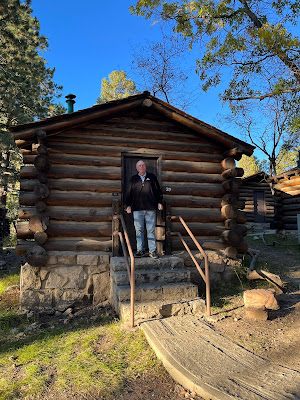We shut the Grand Canyon's North Rim down. No, we weren't rowdy. In fact, it was a pretty quiet place. But we were at the historic Grand Canyon Lodge for its final two days of the 2022 tourist season.
In mid-October, lodging and services at the North Rim close for the winter. The South Rim is open year 'round. We visited the South Rim BC - Before Children - so that's been awhile ago. Staying at the North Rim was on Randy's bucket list.
Accommodations were "rustic," I reported to my family. However, my sister-in-law put things in perspective when she asked if the bathroom was inside the cabin. It was. And she texted back the #winning. Indeed!
The main lodge was built in the 1920s on the lip of the canyon. The Lodge was rebuilt after a fire in 1932. Randy estimates our cabin was only about 100 yards from the rim.
 |
| These photos were taken Saturday afternoon, October 15, as clouds moved in. |
On the first night, we had dinner in the Sun Room and watched the sun set.
The meal was delicious (and expensive). But the meals on the next day were meager, as staff attempted to use up supplies before closing everything down. While refrigerator-case sandwiches were not the culinary highlight of our trip, it was a "million dollar view" all day long.
We were able to watch as the sun began touching the canyon peaks. While the canyon walls themselves may seem unchanging and timeless, the scene changed subtly throughout the day as the sun and shadows moved throughout the canyon.
The overcast skies gave a whole different perspective.
Even though it impacted the drama of sunset that night, it was worth it to watch the afternoon scenes.
Park rangers kept advising us to watch for lightning, which is prone to strike quickly in the high elevations. However, I only saw one bolt, off in the distance. It didn't start raining until nighttime and into the morning as we departed.
Really, I started the story backwards. The photo below was actually our first look at the Grand Canyon on Friday, October 14, as we arrived from Bryce Canyon.
Our first stop was Point Imperial, elevation 8,803, the highest viewpoint in the park.
Roosevelt Point is named for Theodore Roosevelt, who is known for his love of nature. Here's what he had to say after a visit to the Grand Canyon:
Some 900 years ago, prehistoric Indians known as the Kayenta Anasazi lived along the Walhalla Plateau. In the winter, the cold and snow on the rim forced them to inhabit places like the sandy delta of Unkar Creek, where they could continue to farm. During the summer, some of them moved up to the rim to live in seasonal farming communities, where they grew beans, corn and squash. They also hunted in the forests and gathered native plans for food, clothes and medicine. About 1150 A.D., the people left the Canyon, possibly because of a decline in rainfall. They are believed to be the ancestors of the present day Hopi Indians who live east of Grand Canyon.
Angels Window was a highlight of a scenic hike we took as we reached the end of the Cape Royal road.








.JPEG)























I love the photos taken of you and Randy.
ReplyDeleteYour photos truly capure the spectacular beauty of the canyon in its different moods. What an amazing view from your lodge.
It was a memorable trip with such amazing scenery.
Delete